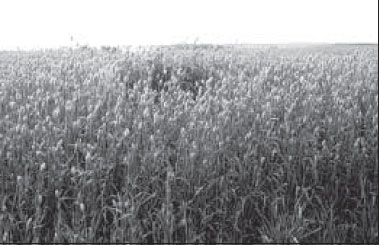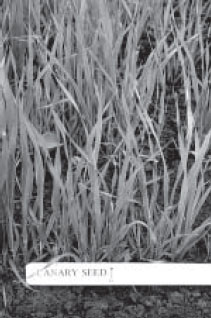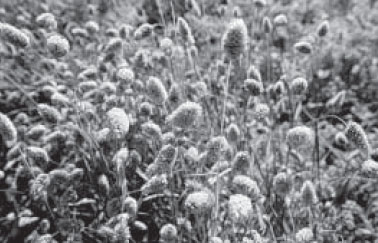| | Introduction
Canary seed (Phalaris canariensis), or annual canary grass, is a major component of feed mixtures for caged and wild birds. It is native to southern Europe and the Middle East. In North America, commercial production of Canary seed started in the U.S. after World War II and was concentrated in Minnesota and North Dakota.
Production of Canary seed began in western Canada in the late 1970's and early 1980's and although production has been cyclical due to fluctuating prices, a record 505,000 acres (204,000 hectares) were grown in western Canada in the 1994-95 crop year. This total is up from the 14,000 acres (5,600 hectares) grown in 1975-76. There were approximately 10,000 acres (4,050 hectares) of Canary seed grown in Alberta in 1995, down from the 22,000 acres (8,900 hectares) grown in 1994.
Internationally, Canada accounted for about three-quarters of the total world Canary seed production of 205,600 tonnes. The bulk of the remainder is grown in Argentina (12 per cent), Australia (3 per cent), Hungary (2.5 per cent) and Mexico (2.5 per cent). Over 90 per cent of the Canadian production was in Saskatchewan in 1995. Over 94 per cent of the total Canadian production is exported, and very little product is utilized domestically.
Description
Canary seed is an annual grass that grows to maturity in 105 to 110 days, or approximately the same number of days as hard red spring wheat. Plants grow to a metre in height at maturity (Figure 1). Seedlings appear spindly upon emergence but begin to tiller at the four-leaf stage, and a dense cover exists at the boot stage (Figure 2).

Figure 1. Canary seed can grow to a metre in height

Figure 2. Dense cover at the boot stage
Seed heads measure from 2 to 5 cm in length (Figure 3). The seed is similar to flax seed in size but is slightly more plump. The seed coat is brown and is covered by a thin, papery, glossy yellow hull. The glossy yellow hull is very attractive to birds, so it is desirable to maintain the hulls while harvesting. The bushel weight of Canary seed is 22.5 kg.

Figure 3. Seed is similar to flax
Adaptation
Canary seed can be grown in most parts of western Canada, with the exception of the drier parts of the brown soil zone. Canary seed is often grown where wheat is successfully grown. It is, however, shallow rooted and is more sensitive to heat and drought stress than wheat.
Canary seed grows well on heavier soils that retain moisture throughout the growing season. Under conditions of high fertility and moisture, Canary seed will tiller extensively and may also lodge. It is considered a cool season crop.
Properties and Uses
Canary seed is used almost exclusively as food for caged and wild birds and is the major component of many commercially prepared bird food mixtures. This limited use means the market is restricted, and there are no alternate uses for the grain.
Agronomy
Varieties
Keet and Elias are the only registered varieties in Canada. They were developed in Minnesota and registered in Canada in 1983 and 1988, respectively. Elias is later maturing, has a larger seed head, a higher test weight and longer straw than Keet. Keet has better lodging resistance than Elias. Breeder seed for both varieties is maintained at the Crop Development Centre of the University of Saskatchewan.
A new glabrous (hairless) cultivar is scheduled for commercial production in 1997. This cultivar will present several advantages for the grower and the Canary seed industry in Canada. Because of the hairless characteristic, irritation at harvest and while handling will be eliminated or lessened. Less secondary processing, oiling and polishing, will be required. Shipping costs will be lessened, as hairlessness will allow for approximately 12 per cent more by volume per container. A distinct market advantage will be gained in the world marketplace
Seeding
Canary seed should be seeded in early May when soil temperatures reach at least 7° C. Immature hard-to-thrash straw should not be a problem if the crop is seeded early in the season. Canary seed can be seeded with conventional equipment, but it must be placed into firm, moist soil because it is small-seeded. Seed should be placed no deeper than 2 in. (5 cm) in depth. The recommended seeding rate is 27 to 35 lb/ac (30 - 38 kg/ha).
Canary seed should not be grown on flax stubble. Volunteer flax in a Canary seed sample is difficult to separate during processing. Also, it should not be grown on or adjacent to land that has grown Canary seed in the past two years. This technique is to avoid potential economic losses from Septoria leaf mottle. Fields with an expected high population of volunteer cereals should not be considered because of the possibility of high competition.
Canary seed is also very susceptible to many herbicide residues. Canary seed should not be grown for at least 24 to 30 months on land that has been treated with trifluralin or ethalfluralin products, depending on applied rates. Canary seed should not be seeded for at least 24 months after an application of Assert®, Fields treated with Ally®, Glean®, Amber®, Pursuit® and Muster® should not be seeded to Canary seed until a field bioassay is completed.
Fertilization
Little research in fertility requirements for Canary seed has been done. Most information sources suggest that nutrient requirements are similar to wheat. Unlike wheat, however, only small amounts of fertilizer can be safely placed with the seed. Canary seed tolerance to seed-placed fertilizer is similar to canola or flax. The actual amount that can be placed with the seed will depend on the seeding equipment used, type of fertilizer, soil type and moisture conditions at the time of seeding.
Irrigation
Approximately 10 per cent of the total Alberta acreage of Canary seed is grown under irrigation. The irrigation requirements of Canary seed are similar to those of barley.
Harvesting
Canary seed is shatter resistant and should br allowed to mature fully before it is harvested. Straight combining is preferred, but swathing just before combing is equally effective. The crop is mature when the kernels are hard, and the heads have turned to a white-beige colour.
Swathing prior to full maturity can present some problems. The straw may take a long time to dry and is very wiry when cut on the green side. Also, the seed may dry more quickly than the straw, which may lead to excessive de-hulling. The crop is less prone to bird damage if it is left standing. The only concern with leaving the crop stand will be snowfall, which could lay it flat.
Canary seed appears to have a frost tolerance similar to wheat and is considered dry at 13 per cent moisture (Canary seed chart). At this moisture level, it will thrash cleanly, and thrashed heads should be checked for any remaining seeds.
Proper combine settings should be made to avoid de-hulling the seed, which is considered dockage. The cylinder or rotor should be run at 500 to 750 rpm, and wind settings should be lower than for wheat but similar to flax. Sieve settings should also be similar to flax. Augers should be run full to decrease de-hulling. De-hulled seed will appear dark brown while whole seed will be shiny and golden yellow.
Tiny hairs at the base of the seed will separate at harvest and may become very irritating to the skin. They can also cause respiratory problems, so dust masks should be worn when handling the crop. Canary seed has yielded up to 1,800 lb/ac (2,000 kg/ha) in Alberta and Saskatchewan, although a yield of 1,000 lb/ac (1,100 kg/ha) is considered more common and a good crop.
Storage
Some care should be taken when handling Canary seed to ensure that augers are run as full as possible at all times. A half empty auger can cause de-hulling, and de-hulled seed is considered dockage.
Because Canary seed is considered dry at 13 per cent moisture (Canary seed chart), it can be safely stored at this moisture content unless green seeds are present. Green seeds will usually ripen with time but could cause overheating; therefore, the grain should be turned one month after harvest.
Canary seed can be stored for long periods without losing grade, provided it is put into storage in good condition. Granaries must be in good shape because Canary seed flows freely and can easily leak through very small openings. Granaries should also be rodent-proof as mouse droppings are difficult to clean out of canary seed .
Pest Management
Weeds
The crop is a very poor competitor with weeds because it develops very slowly, so good stand establishment is important. Several herbicides are registered for Canary seed crops:
- Avenge® and Mataven® for wild oat control
- Laser®, Stampede 360® and Stampede CM® for green foxtail control
- Banvel®, MCPA amine, Buctril M®, Laser®, Pardner®, Stampede CM® and Target® for broadleaf weed control
Applications of 2,4-D ester formulations have caused crop stunting, irregular growth and reduced grain yields.
Diseases
Septoria leaf mottle (Septoria triseti) is a disease of Canary seed first identified in Saskatchewan in 1988 where it caused significant losses in yield and quality. Wet conditions favour the development of Septoria leaf mottle, and it can be difficult to recognize because the contrast between healthy green leaf area and diseased leaf area is not great.
Lower leaves that have been shaded by a dense canopy may have a distinctive symptom, namely "green islands." Green islands are infected spots that remain green as the rest of the leaf yellows. Close inspection of the diseased or discoloured area will reveal a large number of pycnidia (small black spore-producing bodies), which look like pepper sprinkled on the leaf. A magnifying glass will assist in identifying the pycnidia, which are embedded in the leaf.
Under wet conditions, pycnidia ooze golden brown globs of spores that spread to healthy leaves and plants by rain splash. In severe conditions, it can cover the entire plant, including the head. In severe infestations, some of these spores may attach to the seed, and although it is not known whether the fungus can survive and be carried on the seed, it may be advisable to obtain different seed for future planting. There are no fungicides currently available for control of this disease. Ergot can also be a problem in Canary seed in wet years.
Insects
Aphids are the only insects that may cause problems in Canary seed production. They are not usually abundant enough to cause major yield loss. The bird cherry oat aphid and the English grain aphid are the most common species.
Early infestations of aphids will cause the greatest crop injury. At this early stage, the cherry oat aphid feeds on stems, the underside of leaves and in the Canary seed boot (the area where the flag leaf and the stem join prior to heading). Aphids often hide along the stem (rachis) of the Canary seed head, so the head should be bent back and inspected closely to determine infestation levels.
Information from the U.S. and from work with other cereal crops, suggests that 10 to 20 aphids per stem may cause enough crop damage to warrant insecticide application. The economic threshold to justify spraying will also depend on the price of Canary seed at the time. Insecticide application should take place at early heading (early August) when the aphids are present. Do not spray after the soft dough stage as aphids do little economic damage after this time. Malathion and Cygon are registered for the control of aphids in canary seed.
Marketing
Canary seed does not fall under the authority of the Canadian Grain Act, so the Canadian Grain Commission does not have established grades for the grain. The Commission does, however, perform dockage analysis on submitted samples. Canary seed is cleaned to buyers' specifications, usually a minimum purity analysis of 99 per cent, with a maximum 4 per cent de-hulled seed.
Canary seed production contracts are available from a number of grain companies. Although 80 per cent of producers sell into the cash market, production contracts are still encouraged to help manage risk because of a volatile market place. Contracts usually involve deferred delivery options with pooled market pricing options.
Prepared by
Emil deMilliano.
For more information, contact
Alberta Ag-Info Centre
Call toll-free 310-FARM (3276)
Source: Agdex 147/20-1. April 1998. |
|